While having a guitar in your hands is the best way to improve, there are ways you can practice guitar without a guitar.
In this guide, I will explain six different ways you can practice guitar while on vacation, driving, commuting, or whenever you have spare time. You don’t need to have a guitar with you to practice these areas.
If you want to become a better guitarist and a better musician, regularly practice all six. If you don’t have a guitar, you can start practicing right now so you are prepared for when you do get a guitar.
If you’re looking for a way to practice guitar in silence, read this guide. You might be able to squeeze in a late-night practice session by following the tips in that guide.
How Not to Practice Guitar Without a Guitar
Before we look into the six ways you can practice guitar without a guitar, it’s important to look at one way I don’t recommend.
You’ve probably seen these things advertised before:
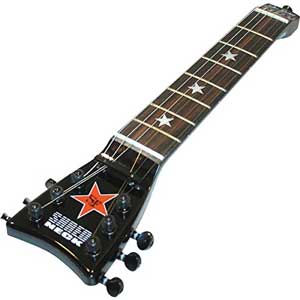
They’re advertised as a way you can practice guitar when you’re away from home. The idea is that you can practice chord positions, riffs, licks, or scale runs without having a guitar.
The reason I don’t recommend these is that it’s wasted practice. Moving your fingers up and down a scale on this thing won’t help you master the scale. To properly practice a scale, it’s all about the coordination between both hands. That’s something you can’t practice on these things.
Instead of buying something like this that won’t make a significant difference in your abilities, I highly recommend working through the six areas below. Each of the six ideas will have a significant impact on your abilities as a guitarist and is worth far more than moving your fingers on a fake guitar neck.
Practice Idea 1: Develop Your Ear With Ear Training
The most important thing you can practice without a guitar in your hands is your ear abilities. Ear training is what separates good guitarists from great musicians. Practicing guitar isn’t just about what our hands are doing – our ears play a massive role.
This cannot be overstated: developing your ear will make you a better guitarist.
Find out about Ear Training in this guide. The guide covers everything you need to know about ear training. Below is a short summary to help you decide whether you want to work on it or not.
Why is Ear Training Important?
Ear training is what gives many guitarists the super-human ability to learn songs just by listening to it. If you’ve ever seen a guitarist jump into a jam and instantly play in the correct key or play a song after only listening to it once, you’ve seen what a well-developed ear can do.
Being able to recognize chords, scales, and notes by ear or accurately identify rhythms may seem impossible at first, but with proper training, you can do it too.
Ear training is an important step in becoming an accomplished guitarist. While there are ways you can practice ear training with a guitar in your hands, ear training is something you can practice without a guitar.
Key point to remember: Practicing guitar will develop your guitar abilities and practicing ear training will develop your musical abilities.
How to Practice Ear Training
There are a few different ways you can practice ear training. The method I recommend is to use an ear training app on your smartphone.
Ear training apps allow you to practice anywhere you go. You don’t need to have a guitar with you and with headphones or earbuds you can practice in public without getting weird looks.
Here is a screenshot of an app I regularly use on Android called ‘Perfect Ear’:
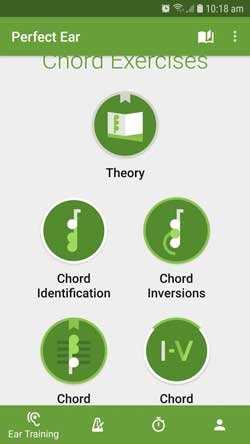
The basic idea behind ear training is that you listen to exercises and try to identify the chords, scales, notes, intervals, and rhythms by ear. The above app gives you a wide range of exercises to teach you how to identify intervals (the distance between two notes), chords, and scales by ear.
Learn the music theory behind intervals in this lesson on Guitar Intervals Explained Simple. If you’ve been avoiding learning music theory, this lesson is a good way to start off.
When you choose an exercise, you hear audio of the chord, scale, or interval. Then you enter on the screen what you think you heard (only the root note is displayed but you hear the full chord):

Pretty simple, right?
You hear a chord play and you simply need to decide whether it was a Major chord or a minor chord.
If you haven’t tried any ear training exercises before, you might be shocked by how hard it can be. Some of the exercises will seem impossible and you will constantly get them wrong. But over time as you continue to practice, you start to get the answers right. Eventually, many intervals, scales, or chords seem obvious and stand out to you. Then more and more exercises start to feel easy.
The strange thing about ear training is that it becomes easy after enough consistent practice. What seemed impossible when you started becomes obvious and easy.
There are a lot of ear training apps out there so I recommend downloading a few different versions to see what you like. Each app will be slightly different, so find one that you like and stick with it.
If you’re not interested in learning to identify chords, intervals, or scales by ear, I still recommend getting an app to work on rhythm training. Being able to sight-read rhythm and accurately play rhythm is a powerful skill to learn that will directly improve your guitar playing.
Ear training tips:
- Commit to practicing ear training every day. Even if you can only practice for 30 seconds today, do it! Build up the habit of training your ears every day and you’ll gradually improve your abilities.
- Use headphones or earbuds. Being able to use an ear training app in silence on the train or in public gives you so much opportunity to develop your ears.
- Don’t give up. At first, ear training will feel impossible and you will get frustrated. But stick with it and keep practicing. It takes a while before you start seeing the benefits of ear training, but the benefits are worth the effort.
If there is one thing you do after reading through all the practice ideas in this guide, I highly recommend you add ear training to your practice routine. You don’t need a guitar to practice ear training, so it’s the perfect thing to practice to develop your abilities as a musician.
Learn more about Ear Training and how to practice it here.
Practice Idea 2: Memorize the Notes on the Fretboard
If you haven’t already memorized the notes on the fretboard and can instantly find any note with ease, this is something you can start practicing without a guitar.
Memorizing the notes on the fretboard takes some time, but it is worth the time. Being able to instantly know what notes you’re playing or to quickly find notes is a crucial step to becoming an accomplished guitarist.
The below image shows all of the notes on a guitar in standard tuning:

If trying to memorize all of the above notes seems overwhelming, the good news is that there are tricks and methods you can use to simplify this task.
My Guide on How to Memorize the Notes on the Fretboard will walk you through some simple exercises to make it as easy as possible to memorize all of the notes.
That guide was written with the idea that you will have a guitar with you, so here are some tips to practice memorizing the notes without a guitar:
- Draw out a fretboard. When you write something down, it sticks in your memory. Draw out a blank fretboard up to the 12th fret, then gradually fill in all the notes. You can do this one string at a time or one note at a time as explained in the above guide. If you do this regularly, you’ll notice that after a few times you start to speed up and it becomes easy.
- Use an app. There are plenty of apps that are designed to help you learn the notes on the fretboard. Most of these apps will place a dot on the fretboard, then you need to identify what the note is. Use one of these apps to work on any areas of the fretboard you’re having trouble with.
- Visualize the fretboard. It might feel weird to try this, but imagine the fretboard in your head and go up and down each string, thinking what each note is. Think to yourself “third fret G, fifth fret A, seventh fret B”. It might feel weird, but it will help you memorize the notes faster.
Practice Idea 3: Memorize Chords and Scales
Having a guitar with you is important when you want to practice chords or scales, but you can still work on your chords and scales knowledge without a guitar.
Memorizing chord shapes before you pick up a guitar makes it easier to practice those chords. If you know exactly what frets you need to play before you pick up a guitar, you’ll master the chords faster.
There are a few different ways you can memorize chords and scales and all of them can be done without a guitar.
Note: if you do not know how to read the chord diagrams, check out this Ultimate Guide to Reading Guitar Chord Diagrams. The guide explains how to read chord diagrams with helpful diagrams, tips, and a printable PDF with easy chords to learn.
Guitar Apps
As you may have guessed, there are plenty of apps you can use to help you memorize chords and scales.
Some apps are designed to act as a library where you can easily look up different chords or scales.
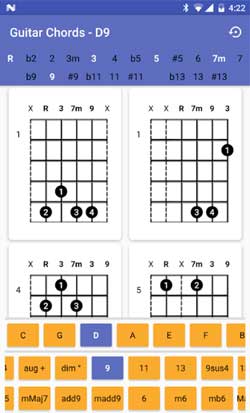
To practice these chords, you simply go through each one and imagine placing your hand on the guitar in the chord shape. Think to yourself “put my first finger on the first fret on the B string. Second finger on the second fret on the D string. Third finger on the third fret on the A string. Play all strings except for the low E string. That’s C Major”.
Alternatively, you can get a flashcard app like Anki, which is designed to help you memorize things. Download a guitar chord, note, or scale pack and you’re good to go.
The idea with flashcard apps is that they show you an image or question (eg: what is the chord C Major?), then you have to try and remember what the answer is. Then you tap the screen and the app shows the correct answer.
This tests out your memory and every time you get an answer wrong, you’ll learn from it.
Guitar Flashcards
If you like the idea of flashcards, but don’t find a suitable app for your device, you can try the old-fashioned method of using physical flashcards.
There are a few different options like this set (link to Amazon).
I created a pack of flashcards of basic open chords to use with my students as shown below:

The idea is that you look at the chord name on the top of the card (nothing is on the back), then try to recall everything you know about the chord. Then you look at the full card to see what you got right and wrong.
Try it with this one:

Think about the chord and try to visualize:
- The note positions on the fretboard
- Which strings you need to play
- Which fingers to use
- The notes in the chord
- What the chord would look like in TAB format
- The chord formula
Once you think you have the answers to all of the above, check your answers against the below card:
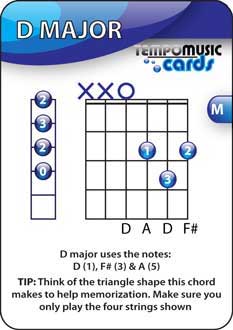
If you got everything right, you place that card in a ‘correct’ pile. If you got one or more of the details wrong, you place the card in an ‘incorrect’ pile.
You then go through each card until you go through the entire pack (50 cards). You then shuffle the ‘incorrect’ pile and go through them again. Eventually, you’ll be able to recall all of the details of every chord on the first attempt.
You can follow this method with any flashcards, but if you’re a beginner and are only getting started with basic open chords, check out my flashcards here.
Practice Idea 4: Active Listening
Most of the time when we listen to music, we’re using passive listening. You might feel like you’re really getting into the song, but there’s a big difference between listening to music and actively listening to music.
Active listening is very different from how we normally listen to music and is an important skill to develop if you want to become a great guitarist.
Once you learn how to actively listen to a song, you’ll start to notice details in guitar parts you didn’t notice before. You’ll notice connections between different instrument parts that help you play better. You’ll also gain a better appreciation of the song.
Make no mistake – active listening requires a lot of focus and effort. You can’t actively listen to music while doing anything else like playing a video game or scrolling through social media. To actively listen to a song, you need to be able to give it 100% of your attention.
How to Actively Listen to a Song
The idea behind active listening is that you put 100% of your focus on a specific part of a song. You might focus on the tone of a guitar part, the techniques you hear, the rhythm, or any other specific element.
You need to zone in on a specific element and keep your focus 100% on that element for the entire song. You may even pause and rewind parts of the song to make sure you completely lock-in with what you hear.
Let’s go through an exercise so you can try active listening.
Pick a short song for this exercise that uses a full band. You want to start with a short song because you’re going to be repeating the song over and over. Once you build up your active listening skills, you can work on longer songs.
Playthrough 1: Play the song and for the entire song, focus completely on the drums.
Pay attention to when you hear the snare and bass drum, how the cymbals accent different parts, and the rhythm of any fills.
Keep your attention 100% on the drums and ignore any vocals you hear. Imagine you need to play the drum parts and how your arms and legs would move to match what you hear.
Playthrough 2: Play the song and for the entire song, focus completely on the bass guitar.
This time, listen carefully to the bass guitar. Pay attention to the tone of the bass, how it sits in the mix behind the guitars, and how it locks in with the drums.
Listen to the riffs and parts and how closely they follow the guitar parts. When you hear the bass play something that doesn’t match the guitar parts, listen to how it fits with the guitar and drums.
Pay attention to how the bass parts match what you hear with the drums. How does the bassist lock-in with the drums and if hear any fills.
Playthrough 3: Play the song and for the entire song, focus completely on the tone of the guitar.
This time, don’t worry about what the guitar is playing. Instead, focus on how the guitar sounds. Imagine you’re a studio engineer and you had the job of recreating that guitar tone from scratch. Listen to the tone as if your job depended on it.
What effects do you hear and what type of settings do you imagine would be set on the pedals to get that sound? If you have trouble identifying effects, check out my Guitar Effects Course. It will walk you through every type of effect and give you practice of identifying them.
If different tones are used throughout the song (eg: drive and clean), listen to how the tones work together. Do you hear a volume change when the tone changes? Do the tones sound like they’re completely different guitars or do they work together?
Try to identify any small details such as delay trails, reverb, or anything else that gives the guitar tone character.
Playthrough 4: Play the song and for the entire song, focus completely on the guitar technique.
This time, listen carefully to what the guitar is playing. If you don’t know how to play the song, imagine what the parts would look like to play. Imagine where you would place your fingers and what techniques you need to use to play the parts.
If you do know how to play the song, listen carefully to how the guitarist is playing every part in detail. Listen for any palm-muting, legato, string noise, bends, etc. Does it sound like the pick is hitting the strings hard or is it played with a lighter touch?
Listen to how the guitar locks in with the drums and bass parts. Where does the guitar match the rhythm of the drums and where does it mix the rhythm up to something different.
Playthrough 5: Play the song and for the entire song, focus completely on the vocals.
Listen to the melody of the vocals and how the vocalist phrases every line. While you could listen to the words, I recommend ignoring the lyrics and focus on the melody, harmony, and rhythm. Imagine the vocals are an instrument without any words and listen to the musical aspect of it.
Does the vocal melody repeat throughout the song or is every line different? Do you hear repeated ideas throughout the song and do some of those melodies match guitar parts?
Listen to the rhythm of the vocals and how it fits with the other instruments.
Finally, focus on any overdubs and how they fit with the main vocals. If you hear any harmonies, count how many you hear and whether they all follow the same melody or bounce around (called counterpoint).
If this is the first time you’ve tried an active listening exercise like the above, you might be surprised by how draining it can be. A lot of effort is required to really hear the details in each instrument. You may need to listen to the song multiple times just to pick up on all the details of a single instrument.
If you go through the above exercise and put 100% effort in, you will immediately see why active listening is very different from how we normally listen to music. It really does take a lot of effort.
If you want to master a song on guitar, I highly recommend actively listening to the song. Actively listen to the song every day as every time you listen to it you will likely notice more details.
Not only does active listening help you better appreciate the music you listen to, but it will help you improve as a guitarist. You will be able to add extra details to your guitar technique to match what you hear in songs.
Any time you have a spare 5-10 minutes and you have headphones/earbuds, actively listen to a song. The more you do this, the better your ears will get at picking up on details you can apply to your own playing.
Practice Idea 5: Learn Music Theory
Music theory is a powerful set of tools you can use to take your playing in different directions. Many guitarists are intimidated by learning music theory and some mistakenly feel that it distracts from your playing.
The reality is that learning music theory simply gives you more options. You can choose to follow the ‘rules’ of music theory (they’re more like guidelines), or you can ignore them when you choose to. A guitarist who properly understands music theory has more options than a guitarist who doesn’t learn it.
Music theory might seem confusing at first, but it’s something you can easily learn without a guitar. There are a few different ways you can work on your music theory understanding without a guitar. Let’s go through a few different ways.
Music Theory Books
There are countless books available that cover all aspects of music theory. Some books will focus on the absolute basics, while others will go into insanely complicated topics.
Finding the right book for you depends on your current understanding of music theory and what you want to learn.
A popular music theory book is The Practical Guide to Modern Music Theory for Guitarists. The book is written for guitarists, so it describes topics and ideas in a way that is easy for guitarists to understand. Plenty of examples are given in both Standard Notation and Guitar TAB.
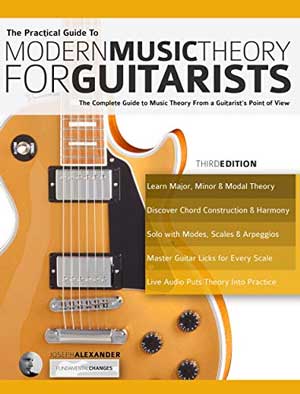
Simply spending time reading a music theory book can help you gain a better understanding of what you’re playing when you pick a guitar up.
Check out this guide for more book recommendations for guitarists. One of the books is a good resource for music theory and the other books cover other important areas of playing and thinking about guitar.
Music Theory Apps
There are some music theory apps available that act as a basic course or an interactive book.
A great benefit of using one of these apps is that they usually provide audio examples throughout. Hearing audio examples helps you understand the concepts.
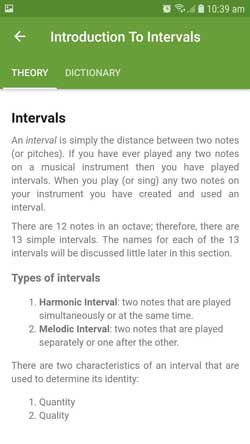
The other benefit of using a music theory app is that you don’t need to take a book with you. But if you don’t mind taking a book with you, I recommend it over an app. From what I’ve seen, the content in a good music theory book has been far better than the apps I’ve tried.
Online Resources
There are plenty of articles and videos online on music theory. I’m gradually adding music theory guides and lessons on this site, so subscribe to updates here if you find my guides and lessons helpful.
The benefit of using online resources is that you can find multiple resources on almost any topic you want. If you want to learn about modes, a simple search on YouTube will reveal countless lessons explaining modes in different ways.
The downside of using YouTube to learn music theory is that it won’t show you what you don’t know to search for. In other words, if you’ve never heard of the term ‘counterpoint’ before, you’ll never search for a video explaining counterpoint.
If you rely 100% on YouTube to learn music theory, you will end up with big gaps in your understanding. That’s why I recommend a good music theory book – it will cover all of the important areas worth learning.
Practice Idea 6: Write Music
The last recommendation on how to practice guitar without a guitar might sound a bit strange, but it can make a big difference to your understanding of the guitar.
At first, it might seem strange or even impossible to write music without a guitar in your hands. But I can tell you from experience it can have a big impact on your music-writing abilities.
When I started writing music as a teenager, I found that I would struggle to come up with original ideas. All the riffs and licks I came up with started off based on other people’s songs.
It wasn’t until somebody recommended I try writing music without a guitar that I started coming up with original ideas.
I would scribble down chord progressions and write out TABs for riffs and licks without having a clue what they would sound like. Then when I would pick up my guitar and play the ideas, I would quickly learn which parts sounded good and which didn’t. Most of the ideas sounded terrible at first.
But I kept practicing writing music without a guitar and things started to change.
After a while, I built an understanding of how to write good parts without having a guitar with me. I could hear the parts in my head and be able to accurately write them down while on the bus to school or sitting in class. Then when I would get home, they would match what I heard in my head.
If you’ve ever wondered how somebody can scribble song parts on a napkin, I can tell you that it’s an easy skill to learn if you practice it enough.
While learning music theory can help you write music without having a guitar in your hands, you can practice this without any music theory understanding. Most of what you write in the beginning won’t sound right. But you’ll quickly learn what sounds good and what doesn’t just as I did.
I highly recommend spending time every week trying to write short riffs, licks, and chord progressions without a guitar. Imagine what those parts sound like and how you would play them.
Then pick up a guitar and play those parts. Do the parts sound like what you heard in your head? If not, make changes to match what you hear in your head.
If you keep practicing this, you’ll find it quickly becomes an easy task and your ability to write music without having a guitar will seem like magic.
Get More From Your Practice
If you practice all six of the above ideas, you’ll develop skills that many guitarists neglect. All six will develop your skills and abilities as a guitarist in different ways. While some of these may be hard at first, they all become easier the more you practice them.
If you want to make the most of your practice when you do have a guitar with you, I highly recommend you set up a good practice space. The space you practice in makes a big difference to the quality of your practice, so it’s worth getting it right.
Read through my guide on Setting up an Ideal Guitar Practice Space. The guide includes plenty of photos of different practice spaces and explains what is good and bad about each one.
